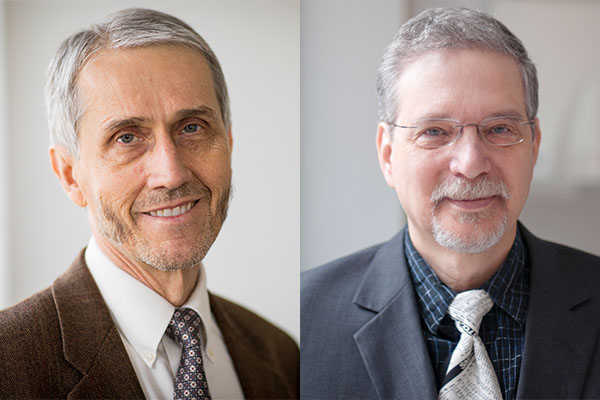Schizophrenia is a chronic and severe mental disorder that affects how a person thinks, feels, and behaves. “Although schizophrenia is not as common as some other mental disorders, the symptoms can be very disabling, said Brian Kirkpatrick, MD, chair of UNR Med’s Department of Psychiatry and Behavioral Sciences. “People with schizophrenia have a wide variety of symptoms, but the most typical symptoms are hallucinations and delusions.”
The causes of schizophrenia are not well understood, but newresearch led by Kirkpatrick and co-authored by Gary Hack, DDS, associate professor at the UMSOD in Baltimore, Md., is shedding light on the question of causation, with findings that may lead to better understanding of the disorder.
The team’s new research has recently been published in Schizophrenia Bulletin, a peer-reviewed journal of psychosis and related disorders. The recent article, titled “An Early Developmental Marker of Deficit versus Nondeficit Schizophrenia,” provides evidence that patients suffering from a specific form of schizophrenia have a wider oral palate than people with other forms of the disease and people without schizophrenia.
Kirkpatrick and Hack teamed with Dr. Fernendez-Egea, a psychiatrist at the University of Cambridge in the U.K., as well as two Turkish investigators, Dr. Özlem Gürbüz Oflezer, adentist from the Department of Prosthetic Dentistry at the Ministry of Health in Istanbul, and Dr. Mehtap Delice Arslan, from the Department of Psychiatry of the Barkirkoy Research and Training Hospital for Psychiatry, Neurology and Neurosurgery in Istanbul.
The international, interprofessional team collaborated on oral palate studies comparing two groups of people with schizophrenia, those with or without “deficit” features. Deficit schizophrenia is a form of the disease in which patients consistently experience at least two negative symptoms of the disease, such as amotivation or asociality. Deficit schizophrenia is thought to be a separate disease from other, nondeficit forms of schizophrenia.
“Our finding of physical orofacial differences in schizophrenia suggests that the whole-body model of this illness is not only more accurate but is a more appropriate model to present to patients, theirfamily members, and students,” said Hack.
“This palate difference in the deficit patients may reflect abnormal development during the pre-natal period,” said Kirkpatrick. “A recognizable palate typically forms between weeks six and 17 during pregnancy, when most neurons travel from their birthplace to their final position in the brain.”
Kirkpatrick plans additional studies of the palate difference and the underlying causes of its development. “If our finding is replicated, the wider palate would be a marker of a different developmental history for deficit compared to nondeficit schizophrenia and would support the concept that deficit schizophrenia is a separate disease within the syndrome of schizophrenia.”
The importance of this finding, said Kirkpatrick “is that it suggests that the development of this group of patients begins to differ from that of other people with schizophrenia as early as the end of the first trimester or the beginning of the second trimester of pregnancy.”
Hack added that the new findings “may point to one pathway to the development of schizophrenia with these negative symptoms that involves specific genes and exposure to a virus.” In the paper, the authors speculate that several factors could account for the development differences and note the greater prevalence of certain antibodies in deficit than in nondeficit patients. This hypothesis would need to be examined in future studies.
“The success of this research advance has depended on very different disciplines coming together to make it happen,” said Kirkpatrick. Hack added that ”it’s been rewarding to collaborate with researchers from around the world, and exciting to find a difference in events from the earliest stage of patients’ lives, which may lead to an understanding of one cause of schizophrenia in this group of patients. International research collaborations make positive impacts on global health possible.”
ABOUT THE UNIVERSITY OF NEVADA, RENO SCHOOL OF MEDICINE
The University of Nevada, Reno School of Medicine, Nevada’s first public medical school, is a community-based, research-intensive medical school with a statewide vision for a healthy Nevada. Established in 1969, UNR Med is improving the health and well-being of all Nevadans and their communities through excellence in student education, postgraduate training and clinical care, research with local, national and global impact and a culture of diversity and inclusion. For more information, visit med.unr.edu. @unrmed|
ABOUT THE UNIVERSITY OF MARYLAND SCHOOL OF DENTISTRY
The University of Maryland School of Dentistry (UMSOD), the world’s first dental college, offers superlative educational programs in oral health. As one of six professional schools and an interdisciplinary Graduate School on the University of Maryland, Baltimore’s 71-acre campus, it is part of a thriving academic health center that combines groundbreaking biomedical research and exceptional patient care. The school is Maryland’s predominant provider of comprehensive and emergency oral health services. @UMSOD_Dentistry
Additional media contact: Tessa Bowen, MPA, Communications Manager, University of Nevada, Reno School of Medicine, Office: (775) 682-9254 I Cell: (402) 617-0120 [email protected]
Original post https://alertarticles.info


